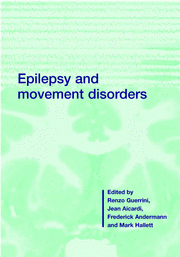Book contents
- Frontmatter
- Contents
- List of contributors
- Preface and overview
- 1 Epilepsies as channelopathies
- 2 Epilepsy and movement disorders in the GABAA receptor β3 subunit knockout mouse: model of Angelman syndrome
- 3 Genetic reflex epilepsy from chicken to man: relations between genetic reflex epilepsy and movement disorders
- 4 Functional MRI of the motor cortex
- 5 Neuromagnetic methods and transcranial magnetic stimulation for testing sensorimotor cortex excitability
- 6 Motor dysfunction resulting from epileptic activity involving the sensorimotor cortex
- 7 Nocturnal frontal lobe epilepsy
- 8 Motor cortex hyperexcitability in dystonia
- 9 The paroxysmal dyskinesias
- 10 Normal startle and startle-induced epileptic seizures
- 11 Hyperekplexia: genetics and culture-bound stimulus-induced disorders
- 12 Myoclonus and epilepsy
- 13 The spectrum of epilepsy and movement disorders in EPC
- 14 Seizures, myoclonus and cerebellar dysfunction in progressive myoclonus epilepsies
- 15 Opercular epilepsies with oromotor dysfunction
- 16 Facial seizures associated with brainstem and cerebellar lesions
- 17 Neonatal movement disorders: epileptic or non-epileptic
- 18 Epileptic and non-epileptic periodic motor phenomena in children with encephalopathy
- 19 Epileptic stereotypies in children
- 20 Non-epileptic paroxysmal eye movements
- 21 Shuddering and benign myoclonus of early infancy
- 22 Epilepsy and cerebral palsy
- 23 Sydenham chorea
- 24 Alternating hemiplegia of childhood
- 25 Motor attacks in Sturge–Weber syndrome
- 26 Syndromes with epilepsy and paroxysmal dyskinesia
- 27 Epilepsy genes: the search grows longer
- 28 Genetics of the overlap between epilepsy and movement disorders
- 29 Seizures and movement disorders precipitated by drugs
- 30 Steroid responsive motor disorders associated with epilepsy
- 31 Drugs for epilepsy and movement disorders
- Index
- Plate section
19 - Epileptic stereotypies in children
Published online by Cambridge University Press: 03 May 2010
- Frontmatter
- Contents
- List of contributors
- Preface and overview
- 1 Epilepsies as channelopathies
- 2 Epilepsy and movement disorders in the GABAA receptor β3 subunit knockout mouse: model of Angelman syndrome
- 3 Genetic reflex epilepsy from chicken to man: relations between genetic reflex epilepsy and movement disorders
- 4 Functional MRI of the motor cortex
- 5 Neuromagnetic methods and transcranial magnetic stimulation for testing sensorimotor cortex excitability
- 6 Motor dysfunction resulting from epileptic activity involving the sensorimotor cortex
- 7 Nocturnal frontal lobe epilepsy
- 8 Motor cortex hyperexcitability in dystonia
- 9 The paroxysmal dyskinesias
- 10 Normal startle and startle-induced epileptic seizures
- 11 Hyperekplexia: genetics and culture-bound stimulus-induced disorders
- 12 Myoclonus and epilepsy
- 13 The spectrum of epilepsy and movement disorders in EPC
- 14 Seizures, myoclonus and cerebellar dysfunction in progressive myoclonus epilepsies
- 15 Opercular epilepsies with oromotor dysfunction
- 16 Facial seizures associated with brainstem and cerebellar lesions
- 17 Neonatal movement disorders: epileptic or non-epileptic
- 18 Epileptic and non-epileptic periodic motor phenomena in children with encephalopathy
- 19 Epileptic stereotypies in children
- 20 Non-epileptic paroxysmal eye movements
- 21 Shuddering and benign myoclonus of early infancy
- 22 Epilepsy and cerebral palsy
- 23 Sydenham chorea
- 24 Alternating hemiplegia of childhood
- 25 Motor attacks in Sturge–Weber syndrome
- 26 Syndromes with epilepsy and paroxysmal dyskinesia
- 27 Epilepsy genes: the search grows longer
- 28 Genetics of the overlap between epilepsy and movement disorders
- 29 Seizures and movement disorders precipitated by drugs
- 30 Steroid responsive motor disorders associated with epilepsy
- 31 Drugs for epilepsy and movement disorders
- Index
- Plate section
Summary
Introduction
Abnormal, seemingly purposeless, repetitive motor behaviours are typical manifestations of seizures of temporal or frontal origin and are referred to as automatisms. In adults, these ‘epileptic automatisms’ or ‘epileptic stereotypies’ (Penfield & Jasper, 1954), are usually recognized as clearly different fromthe normal patient's behaviour and also because there are usually other simultaneous manifestations of temporal or frontal seizures. However, in very young children and especially when stereotypies are the only epileptic symptoms, the situation is more complicated, because stereotypies can be seen in a variety of circumstances and have very different causes.
Before further discussion of ‘epileptic stereotypies’, the use of the term ‘stereotypy’ needs first to be clarified (Ridley, 1994; Mason, 1991). Stereotypies are defined as repetitive, similar, non-goal-directed (purposeless) movements. This definition is wide and can apply to many types of abnormal movements, for example tremors and tics. It leaves many open questions: repetitive implies a certain frequency and regularity of successive occurrence, but this can be quite variable. Similar means that the movement is always the same, but variations in intensity, rapidity and complexity are frequently observed from one episode of stereotypy to the next. The movement itself can be simple and without apparent significance, or complex and in this case appears as an organized deliberate gesture which is part of the person's repertoire. Finally, non-goal directed implies that it is involuntary and automatic and beyond the person's control. However, stereotypies can appear goal directed even if they are not made with a deliberate intention (for instance, chasing an insect on one's face). The dichotomy automatic/voluntary is not so straightforward as one might think (Jeannerod, 1983). These difficulties should be acknowledged when using the term clinically.
- Type
- Chapter
- Information
- Epilepsy and Movement Disorders , pp. 319 - 332Publisher: Cambridge University PressPrint publication year: 2001



